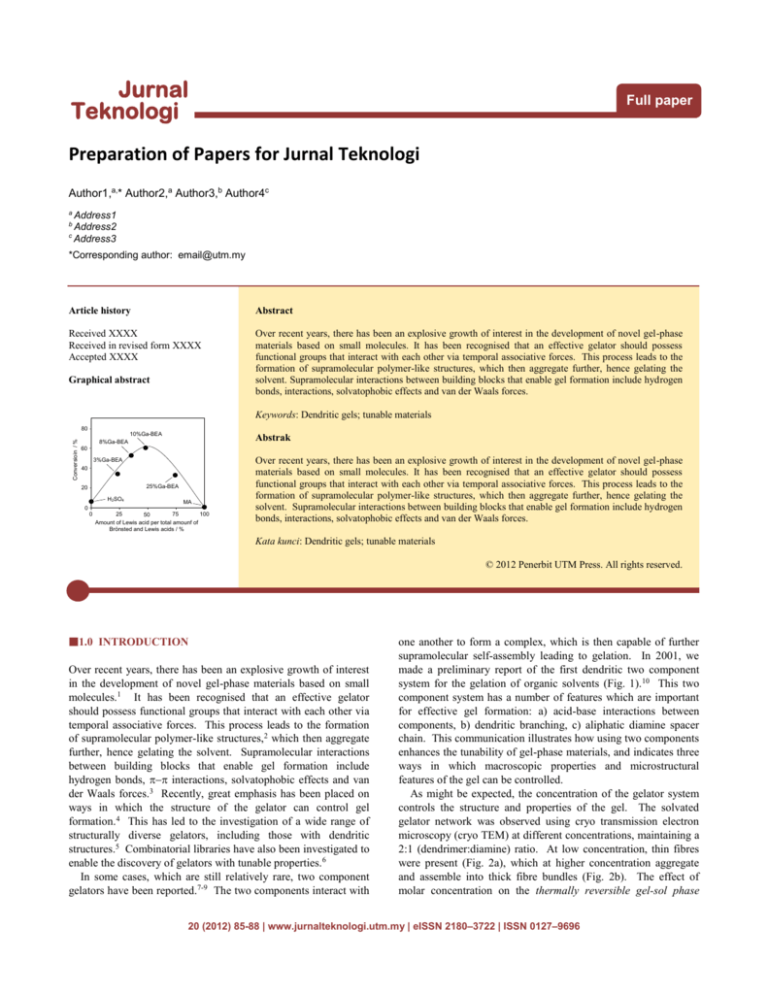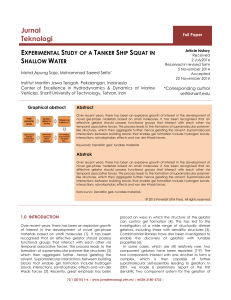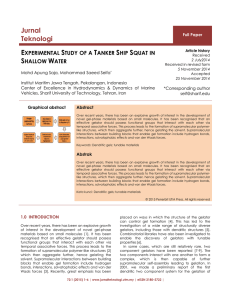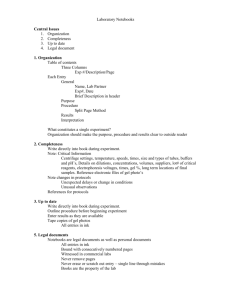
Jurnal
Teknologi
Full paper
Preparation of Papers for Jurnal Teknologi
Author1,a,* Author2,a Author3,b Author4c
a
Address1
Address2
c
Address3
b
*Corresponding author: email@utm.my
Article history
Abstract
Received XXXX
Received in revised form XXXX
Accepted XXXX
Over recent years, there has been an explosive growth of interest in the development of novel gel-phase
materials based on small molecules. It has been recognised that an effective gelator should possess
functional groups that interact with each other via temporal associative forces. This process leads to the
formation of supramolecular polymer-like structures, which then aggregate further, hence gelating the
solvent. Supramolecular interactions between building blocks that enable gel formation include hydrogen
bonds, interactions, solvatophobic effects and van der Waals forces.
Graphical abstract
Keywords: Dendritic gels; tunable materials
Conversioin / %
80
10%Ga-BEA
Abstrak
8%Ga-BEA
60
3%Ga-BEA
40
25%Ga-BEA
20
H2SO4
MA
0
0
75
100
25
50
Amount of Lewis acid per total amounf of
Brönsted and Lewis acids / %
Over recent years, there has been an explosive growth of interest in the development of novel gel-phase
materials based on small molecules. It has been recognised that an effective gelator should possess
functional groups that interact with each other via temporal associative forces. This process leads to the
formation of supramolecular polymer-like structures, which then aggregate further, hence gelating the
solvent. Supramolecular interactions between building blocks that enable gel formation include hydrogen
bonds, interactions, solvatophobic effects and van der Waals forces.
Kata kunci: Dendritic gels; tunable materials
© 2012 Penerbit UTM Press. All rights reserved.
1.0 INTRODUCTION
Over recent years, there has been an explosive growth of interest
in the development of novel gel-phase materials based on small
molecules.1 It has been recognised that an effective gelator
should possess functional groups that interact with each other via
temporal associative forces. This process leads to the formation
of supramolecular polymer-like structures,2 which then aggregate
further, hence gelating the solvent. Supramolecular interactions
between building blocks that enable gel formation include
hydrogen bonds, interactions, solvatophobic effects and van
der Waals forces.3 Recently, great emphasis has been placed on
ways in which the structure of the gelator can control gel
formation.4 This has led to the investigation of a wide range of
structurally diverse gelators, including those with dendritic
structures.5 Combinatorial libraries have also been investigated to
enable the discovery of gelators with tunable properties.6
In some cases, which are still relatively rare, two component
gelators have been reported.7-9 The two components interact with
one another to form a complex, which is then capable of further
supramolecular self-assembly leading to gelation. In 2001, we
made a preliminary report of the first dendritic two component
system for the gelation of organic solvents (Fig. 1).10 This two
component system has a number of features which are important
for effective gel formation: a) acid-base interactions between
components, b) dendritic branching, c) aliphatic diamine spacer
chain. This communication illustrates how using two components
enhances the tunability of gel-phase materials, and indicates three
ways in which macroscopic properties and microstructural
features of the gel can be controlled.
As might be expected, the concentration of the gelator system
controls the structure and properties of the gel. The solvated
gelator network was observed using cryo transmission electron
microscopy (cryo TEM) at different concentrations, maintaining a
2:1 (dendrimer:diamine) ratio. At low concentration, thin fibres
were present (Fig. 2a), which at higher concentration aggregate
and assemble into thick fibre bundles (Fig. 2b). The effect of
molar concentration on the thermally reversible gel-sol phase
20 (2012) 85-88 | www.jurnalteknologi.utm.my | eISSN 2180–3722 | ISSN 0127–9696
Author et al. / Jurnal Teknologi (Sciences & Engineering) 58 (2012) 85–88
transition (Tgel) was monitored using the tube inversion
technique.11 The validity of this approach, and the reversibility of
the phase transition, was checked with differential scanning
calorimetry. As the molar concentration of the dual components
Table 1 Catalytic alkylation of resorcinol to 4-tert-butyl resorcinol and 4,6-di tert-butyl resorcinol a
Entry
Catalysts
Conversion / %
Product yield /
mmol
Selectivity / %
4-tert butyl
resorcinol
1
MA
2
Ratio of Lewis acid to
Brönsted acid b
4,6-di tert-butyl
resorcinol
0
0
0
0
0
3%Ga-BEA
38.0
15.6
97.4
2.6
0.5
3
8%Ga-BEA
54.4
21.7
95.8
4.2
0.7
4
10%Ga-BEA
59.1
23.6
100
0
1.0
5
25%Ga-BEA
32.2
12.9
100
0
1.5
6
H2SO4 c
6.5
2.6
96.0
4.0
7
MA + H2SO4
6.0
2.4
96.0
4.0
contain only Brönsted acid
1.0
d
a
b
c
d
All reactions were carried out at 80 °C for 8 h with resorcinol (40 mmol), MTBE (60 mmol) and catalyst (0.2 g) with vigorous stirring.
The ratio of Lewis acid to Brönsted acid is calculated by using the peak area of peaks at wavenumber of 1540 cm -1 and 1450 cm-1 for Brönsted and
Lewis acids, respectively (see Fig. 1).
The amount of H2SO4 is 25 mol.
The MA in a solution containing H2SO4. The amount of MA and H2SO4 are similar as entries 1 and 6, respectively.
was increased, Tgel also increased (Fig. 2c).
Figure 1 SEM of 2:1 (dendrimer:diamine) gelation system A in toluene
[Dendritic Branch] = 9 mM, [Aliphatic Diamine] = 3 mM
2.0 EXPERIMENTAL
4.0 CONCLUSION
In a two-component gel, it is easy to modify the molecular
structure of either of the two components.
3.0 RESULTS AND DISCUSSION
Most interestingly, the ratio of the two components has a
profound effect on the microscopic structure and macroscopic
properties of the gel in toluene.
Conversioin / %
80
Acknowledgement. We are grateful for the UTM scholarship to
Author 1.
10%Ga-BEA
8%Ga-BEA
References
60
(1)
(2)
3%Ga-BEA
40
25%Ga-BEA
20
H2SO4
MA
0
0
The nature of the aggregates present in dilute solution, below the
gelation threshold concentration, was investigated using atomic
force microscopy (AFM). When the two components were
present in a 2:1 (dendrimer:diamine) ratio, rod like aggregates
were observed in the AFM images (Fig. 4a – shows aligned rods
running from upper left to lower right). The lngth of these rods
was approximately 100 nm, and their diameters were ca. 9 nm
(depth ca. 1 nm).
75
100
25
50
Amount of Lewis acid per total amounf of
Brönsted and Lewis acids / %
(3)
(4)
(5)
(6)
(7)
(8)
P. B. Moore, J. Louisnathan. 1967. Science. 156: 1361.
A. M. Valentine. 2006. Titanium: Inorganic and Coordination
Chemistry. Encyclopedia of Inorganic Chemistry. New York: Wiley.
B. Notari. 1993. Catalysis Today. 18: 163.
H. Nur, S. Ikeda, B. Ohtani. 2001. J. Catal. 204: 402.
V. A. Zeitler, C. A. Brown. 1957. J. Phys. Chem. 61: 1174.
G. P. Pez, P. Apgar, R. K. Crissey. 1982. J. Am. Chem. Soc. 104: 482.
E. Astorino, J. B. Peri, R. J. Willey, G. Busca. 1996. J. Catal. 157: 482.
R. H. Glaser, G. L. Wilkes, C. E. Bronnimann. 1989. J. Non-Cryst.
Solids. 113: 73.
Author et al. / Jurnal Teknologi (Sciences & Engineering) 58 (2012) 85–88






